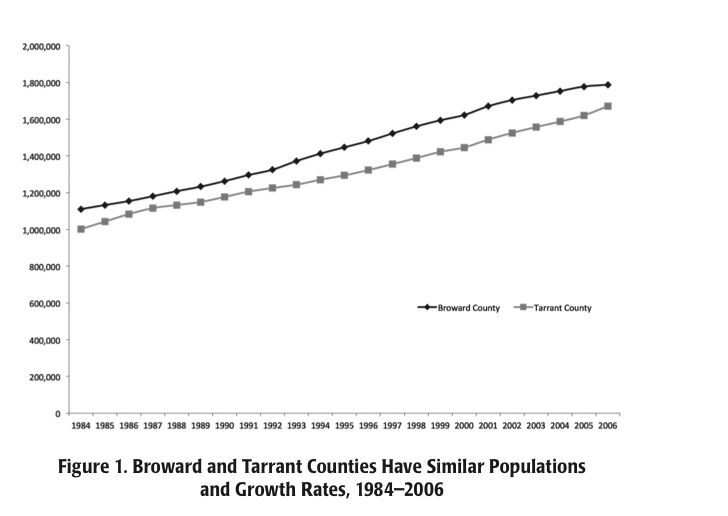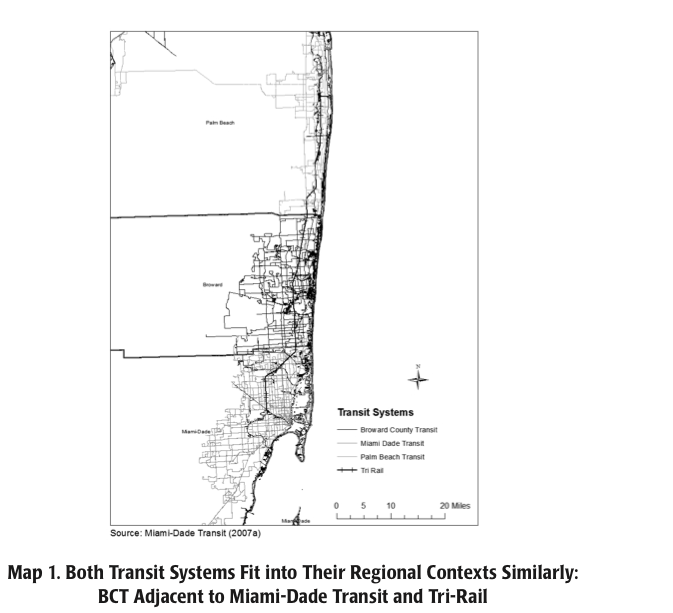FLORIDA STATE UNIVERSITY: CENTER FOR URBAN TRANSPORTATION RESEARCH
Jeffrey R. Brown and Gregory L. Thompson
Introduction
This case study seeks to understand the relative efficacy of two classes of policies intended to increase the ridership and productivity of public transit service. One class of policies seeks to improve transit effectiveness by freezing transit service in the older parts of metropolitan areas. It is thought that higher densities of population and employment and the presence of pedestrian amenities in older areas induce higher levels of transit demand. Policy should attempt to direct population and employment growth to such areas, particularly around transit stops. The other class of policies seeks to connect employment and population, wherever it locates, as directly as possible by transit routes. The thrust of transit development of this second category of policies is in the newer rather than older parts of metropolitan areas, because it is in the newer areas that most population and employment growth is located.
The analysis contrasts transit development objectives and transit performance in Broward County, Florida, with those in Tarrant County, Texas. Transit development policy in the two counties is comparable, because both counties are similar in population size and growth rates, and both are situated similarly in their respective metropolitan areas, which are Miami and Dallas-Ft. Worth. Their transit systems also are both the second largest in their respective metropolitan areas. They differ primarily in the fact that Tarrant County contains a traditional CBD, and transit is organized around it. Employment in other parts of the county, which are much newer, is overlooked as a transit destination. Transit in Broward County serves all employment. Broward County lacks a CBD and is one vast suburb that developed during the auto era. Transit development objectives in Broward County generally reflect the second category of policies; those in Tarrant County generally reflect the former.
The Debate Over How Transit Should be Organized
The conventional wisdom is that transit works best when it focuses on serving the CBD commute market (Ferreri 1992, Meyer and Gomez-Ibanez 1981, Pisarski 1996, Taylor 1991). One researcher found that CBD employment is an important predictor of transit patronage (Hendrickson 1986); another found that employment decentralization explained transit patronage decline (Gomez-Ibanez 1996). The implication is that transit agencies should structure their service to feed the CBD and provide high quality service to that destination, because, as the literature would suggest, that is where riders wish to travel. An agency decision to serve other destinations, particularly those dispersed throughout the suburbs, is criticized for being an inefficient use of public subsidy (Taylor 1991) and for resulting in low service productivity (Ferreri 1992, Meyer and Gomez-Ibanez 1981).
A problem with all of these studies is that they did not examine the results of transit systems that explicitly attempted to serve suburban employment. Their approach was to track the patronage of CBD-centered transit systems that sent routes ever-farther into the suburbs in attempts to lure passengers to jobs in the CBD. Brown and Thompson (2008), however, found that extension of coordinated rail/bus transit service to jobs in suburban Atlanta resulted in patronage growth, whereas growth of jobs in other parts of Atlanta not served by transit resulted in patronage decline. Controlling for numerous variables in a crossectional study of transit patronage in the U.S., Brown and Neog (2007) found that CBD employment had no effect on patronage growth. This study joins the debate by explicitly comparing transit performance in two regions. In one, serving CBD employment is the major objective of transit policy. In the other, serving all employment is the major objective of transit policy.
Read full report (PDF) here: Should Transit Serve the CBD or a Diverse Array of Destinations?
About the Center for Urban Transportation Research (CUTR)
www.cutr.usf.edu
“The Center for Urban Transportation Research (CUTR), established in 1988, has become recognized nationally and serves as an important resource for policymakers, transportation professionals, the education system, and the public. With emphasis on developing innovative, implementable solutions to transportation problems, CUTR provides high quality, objective transportation expertise in the form of technical support, policy analysis, and research support that translates directly into benefits for its project sponsors.”
Tags: Broward County, CBD, Center for Urban Transportation Research, CUTR, Florida State University, FSU, Gregory Thompson, Jeffrey Brown, Tarrant County, transit development








 RSS Feed
RSS Feed